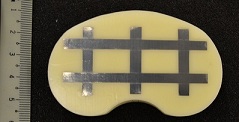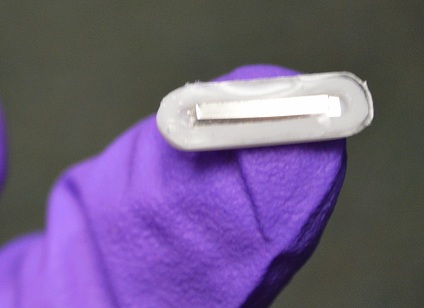|
|
|||
|
|
Research Focus The biosensors laboratory focuses on development of wireless
implantable sensors for human physiological measurements. Current research
interests include the magnetic harmonic sensors, the inductor-capacitor
resonant-circuit (LC) sensors, and the magnetoelastic sensors. This
laboratory also collaborates with Engineered
Biomaterials Laboratory to develop a magnetoelastic vibrational coating for suppressing
biofouling and controlling cell proliferation. This
laboratory is equipped with standard device fabrication instruments
such as circuit fabrication station, as well as device characterization
equipments such as high-frequency spectrum/network analyzers, waveform
generators, and various amplifiers and filters. This lab is also
capable of rapid prototyping with equipments such as a CNC milling
machine, a 3D printer, and a 3D scanner. This lab also has standard
chemistry equipments for sensor functionalization. |
||
|
|
Magneto Harmonic Shift
Sensors The magneto
harmonic shift (MHS) sensors are based on two adjacently placed ferromagnetic strips: one
magnetically soft and the other magnetically hard. When the separation
distance between these two strips varies, the magnetic signature from the
soft magnetic strip changes, allowing wireless detection of the sensor
response by measuring the change in induced magnetic field. |
||
|
|
Pressure monitoring in abdominal aortic aneurysm sac The
implantable pressure sensor is designed for monitoring pressure inside
an abdominal aortic aneurysm sac. Changes in ambient pressure deflect
the membranes, thus changing the separation distance between the
biasing element (hard magnetic strip) and sensing element (soft
magnetic strip). This alters the sensor signature allowing remote
pressure monitoring by measuring the changes in magnetic field. |
||
|
|
|||
 | Magnetoelastic Harmonic Sensors This
wireless force mapping sensor system is designed for real-time
monitoring of compressive forces on knee implants. Since magnetoelastic
material changes its magnetization property with the applied force, an
array of magnetoelastic strips, detected via a set of detection coils,
can be used to map the surface profile on a knee implant (the PE
insert) wirelessly. | ||
|
|
Inductor Capacitor Resonant Circuit Sensors The LC sensor is made of
a planar inductor and capacitor printed on a substrate. To monitor parameters
of interest, the sensor is embedded inside the test medium and its response is
remotely detected through a coil connected to a sensor reader. Parameters
such as humidity and various gases are detected by applying a chemically
responsive coating on the capacitor. As the target parameter changes, the
coating changes the capacitorís capacitance and this leads to changes in the
sensorís resonant frequency. The biosensors laboratory is currently applying
this sensor technology for monitoring food quality and humidity inside civil
infrastructures. A wound healing monitoring sensor is also being fabricated
based on the LC sensor technology. |
||
|
|
|
||
|
Various designs of the
inductor-capacitor resonant circuit sensors |
|||
|
|
Magnetoelastic Sensors Another
focus of this lab is the development of a disposable sensor for rapid
microbial detection. Potential applications include controlling of food
quality and safety (E. coli) as well as monitoring nosocomial
infections (MRSA). The sensor is based on an array of magnetically
interrogated, vibrating magnetoelastic sensors functionalized with proteins,
antibodies and/or phages. Bacteria detection is realized by tracking the
change in the resonance frequency and/or amplitude of the sensor, which is
caused by the mass increase when the bacteria bind to the functional coating.
The strength of the bonds is also measured by linearly increasing the sensor
vibration until a bond-breaking event is observed. Specific bacteria
identification is achieved by analyzing the bond strengths between the target
bacteria and the sensor array. |
||
|
|
|||
|
(Left) Target analytes
attached to the sensor. (Right) Sensor vibration removes non-binding analytes
from its surface. |
|||
|
|
Magnetoelastic Vibrational Coating In collaboration
with the Engineered Biomaterials Lab, we are developing a remotely controlled
antifouling coating for reducing biofilm growth on biomedical implants. The
coating is based on a magnetoelastic layer that vibrates in the presence of a
magnetic AC field. Through an adjacently located device that generates
controllable magnetic fields, the coating can be set to vibrate at a
predetermined amplitude and frequency as a means for biofilm growth
management. The novelty of this technology is that the coating characteristic
can be remotely altered after deployment in vivo through changing
magnetic field strength. In addition, it is also possible to monitor biofilm
growth on the coating in vivo by measuring the changes in the magnetic
field signature from the coating (coating vibration generates a secondary
magnetic flux that can be independently monitored). The ability to measure
biofilm growth and adjust the coating characteristic in vivo allows
the creation of a smart antifouling coating that can precisely control
biofilm formation by activating the vibration only when it is needed. |
||
|
|
|||
|
|
|||










